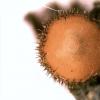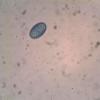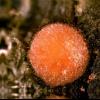
02-12-2025 18:59
This pair of ascos 2.5cm across were on recently b

02-12-2025 19:25
Buckwheat PeteHello, can anyone identify this hairy fungus growi

30-11-2025 12:53
 Edvin Johannesen
Edvin Johannesen
White short-stipitate apothecia found on thin twig

30-11-2025 10:47
 William Slosse
William Slosse
I recently found a collection of small Peziza sp.

27-11-2025 12:01
Thomas Læssøehttps://svampe.databasen.org/observations/10496727

27-11-2025 11:46
Thomas Læssøehttps://svampe.databasen.org/observations/10493918
Two more Scutellinia
Malcolm Greaves,
10-10-2012 01:31
Found on a log which had been kept artificially wet. Small at 1.5mm
Spores 17-19.2 x 11.36-11.94 with small warts with noticable connections.
Hairs max 666 x 38 multifurcate.
This leads (me) to S vitreola which does not look much like my find.
Thanks as ever
Malcolm
Beñat Jeannerot,
10-10-2012 05:45

Re : Two more Scutellinia
Adio Malcolm,
Typical hairs bases, typical sporal ornementation and form of spores. In my mind, this is Scutellinia crinita, a young specimen, so that explains the short hairs.
S. vitreola is different.
Beñat
Typical hairs bases, typical sporal ornementation and form of spores. In my mind, this is Scutellinia crinita, a young specimen, so that explains the short hairs.
S. vitreola is different.
Beñat
Malcolm Greaves,
11-10-2012 01:08
Re : Two more Scutellinia
Thanks again.
When the length of the hairs cannot be counted on as a defining feature it does make it difficult but noone said it would be easy.
Mal
When the length of the hairs cannot be counted on as a defining feature it does make it difficult but noone said it would be easy.
Mal
Malcolm Greaves,
12-10-2012 01:22
Re : Two more Scutellinia
Beñat?
I went back and collected another more mature sample (3mm across). the hairs are still mostly under 650 um (after some searching the longest I could find was 730)
If you are still convinced it is S crinita I will happily log it as that. Unfortuntately the British Checklist (supported by an article by Brian Spooner) has this as a synonym of S scutellata so it will be recorded as that but with a note that I believe it is S crinita.
Thanks
Malcolm
I went back and collected another more mature sample (3mm across). the hairs are still mostly under 650 um (after some searching the longest I could find was 730)
If you are still convinced it is S crinita I will happily log it as that. Unfortuntately the British Checklist (supported by an article by Brian Spooner) has this as a synonym of S scutellata so it will be recorded as that but with a note that I believe it is S crinita.
Thanks
Malcolm
Beñat Jeannerot,
12-10-2012 04:50

Re : Two more Scutellinia
Adio Mal,
I'm not sure that represents S. crinita. It's not possible because I haven't seen the specimen and it's difficult to see sporal ornementation with just one spore.
In fact, hairs are typical, but other species are possible with this form of hairs.
About your hypothesis, S. scutellata : it's a long work, not finished today for a lot of reasons :
- S. scutellata was the name most used in the past but this is not a common species and it must come to identify specific limits.
- Currently, we have clearly identified S. crinita, very common, and S. pilatii (Svrcek typus + Schumacher's collection + DNA of personal collections from Pyrenees).
- Several other collections (herbaria + personal) refer to something else, which I call "scutellata complex" for now.
- In addition, like you say, Yao & Spooner proposed synonymy (crinita and scutellata), which is not a good idea, in my mind.
But, now, I'm unable to say what is S. scutellata precisely...
It's a long work and we have the same work in "umbrorum" complex and "nigrohirtula" complex...
Beñat
I'm not sure that represents S. crinita. It's not possible because I haven't seen the specimen and it's difficult to see sporal ornementation with just one spore.
In fact, hairs are typical, but other species are possible with this form of hairs.
About your hypothesis, S. scutellata : it's a long work, not finished today for a lot of reasons :
- S. scutellata was the name most used in the past but this is not a common species and it must come to identify specific limits.
- Currently, we have clearly identified S. crinita, very common, and S. pilatii (Svrcek typus + Schumacher's collection + DNA of personal collections from Pyrenees).
- Several other collections (herbaria + personal) refer to something else, which I call "scutellata complex" for now.
- In addition, like you say, Yao & Spooner proposed synonymy (crinita and scutellata), which is not a good idea, in my mind.
But, now, I'm unable to say what is S. scutellata precisely...
It's a long work and we have the same work in "umbrorum" complex and "nigrohirtula" complex...
Beñat
Malcolm Greaves,
12-10-2012 10:20
Re : Two more Scutellinia
Beñat?
Thanks again for the comprehensive reply. This can join my growing collection of unknown specimens.
Malcolm
Thanks again for the comprehensive reply. This can join my growing collection of unknown specimens.
Malcolm




